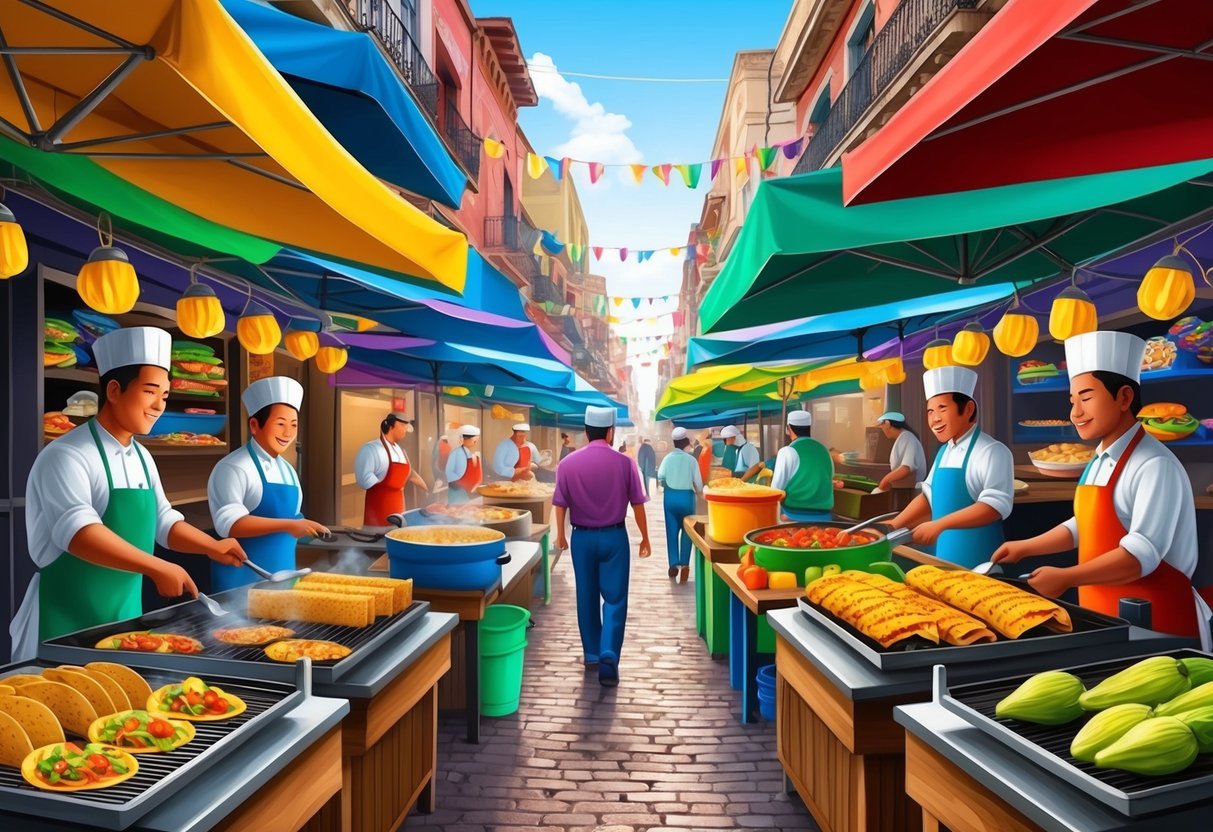
Mexican cuisine is celebrated worldwide for its vibrant tastes. Nowhere are these authentic flavors more apparent than at streetside stalls and bustling markets.
Authentic Mexican street food brings together generations of traditional recipes using simple ingredients and time-honored techniques. The result is unforgettable dishes like tacos al pastor, tamales, sopes, and Mexican street corn.
These classic foods aren’t just snacks—they’re a cultural experience and a direct connection to the rich culinary history of Mexico.
Exploring Mexican street food is a practical way to discover both well-known favorites and hidden gems. Each offers a unique taste profile rooted in regional traditions.
Whether intrigued by the smokiness of grilled meats, the freshness of salsas, or the comforting texture of masa, enthusiasts and newcomers alike can find inspiration through homemade versions of these dishes. There are easy-to-follow authentic Mexican street food recipes that make it possible to recreate this street-side magic in any kitchen.
For those seeking genuine taste, incorporating signature ingredients and classic methods is key to capturing the true spirit of traditional Mexican food.
Essential Ingredients in Mexican Street Food
Traditional Mexican street food showcases a vibrant array of flavors, textures, and colors. Each element is carefully selected to complement the others, creating dishes that are both familiar and distinctive in taste.
Maize and Tortillas
Maize, or corn, is the backbone of Mexican cuisine, consistently present in street food classics. It is most often processed into masa harina, a special corn flour used to create iconic items like corn tortillas, tamales, and sopes.
The process of nixtamalization, where corn is treated with lime, not only boosts nutritional value but also deepens the characteristic flavor. Tortillas serve as the foundation for countless favorites such as tacos, quesadillas, and tostadas.
Freshness is crucial; handmade tortillas deliver a slight chewiness and rich corn aroma that packaged varieties simply can’t match. These flatbreads act as canvases for savory fillings, creating the unmistakable taste of authentic street food.
For more on traditional uses of corn and masa, see this informative guide on essential ingredients in Mexican cooking.
Chilies and Chipotle
Chilies are essential for developing the layered heat and flavor that define true Mexican street fare. Both fresh and dried varieties are used, each providing unique notes and intensity.
Common fresh chilies include jalapeños and serranos, while dried options embrace guajillo, ancho, and pasilla peppers. Chipotle, a smoked and dried jalapeño, imparts a distinctive smoky depth that is prized in many dishes.
Chilies enliven salsas, moles, marinades, and adobos, delivering heat ranging from mild to intense. Preparation methods—grilling, toasting, or rehydrating—further broaden their flavor impact.
Incorporating different chilies gives each vendor’s food its specific character. Learn about essential chili varieties in this Mexican pantry guide.
Beans and Black Beans
Beans are a vital protein source, deeply integrated into the culinary makeup of Mexican street food. Black beans, pinto beans, and sometimes refried beans are featured in tacos, burritos, tamales, and tortas.
Black beans stand out for their earthy flavor and creamy consistency, making them especially popular. These legumes are often simmered with aromatics like onion, garlic, and Mexican oregano, producing a comforting, fragrant base.
Whether used whole, mashed, or refried, beans offer nutrition and substance, balancing richer street foods and adding hearty texture. Simple beans, seasoned with minimal ingredients, can steal the spotlight in tacos or serve as a versatile side.
Lime Juice and Fresh Garnishes
Lime juice is the finishing touch found throughout Mexican street food, brightening flavors with its citrus tang. Squeezed over tacos, elotes, or ceviche, lime juice sharpens taste and cuts through fatty or spicy elements.
It’s a small addition with a pronounced effect, often included right at the point of serving for maximum freshness. Fresh garnishes—like diced onions, chopped cilantro, radish slices, avocado, and shredded lettuce—add contrast, crunch, and even color.
These toppings aren’t chosen randomly; each plays a role in enhancing both aroma and taste, while making every bite visually appealing. Pico de gallo, a fresh salsa of tomato, onion, cilantro, and lime, is another staple that brings vibrancy to the street food experience.
Dive deeper into garnishes and flavor builders in this exploration of Mexican street food.
Classic Tacos: The Heart of the Streets
Tacos are central to Mexican street food, offering an incredible variety curated by local traditions and ingredients. Each style uses distinct proteins, marinades, and toppings, balancing vibrant salsas, aromatic herbs, and robust seasonings for genuine flavor.
Tacos al Pastor
Tacos al pastor are a signature Mexico City street food, inspired by Lebanese shawarma. Marinated pork is stacked on a vertical spit called a trompo, then slow roasted and sliced thin.
The pork gains a smoky, slightly sweet flavor profile from an adobo marinade made of dried chiles, achiote paste, pineapple juice, and spices. Traditional toppings are simple: diced onions, fresh cilantro, and slices of caramelized pineapple.
The pineapple is more than garnish—it adds a bright, acidic contrast that balances the spices and pork fat. Warm, soft corn tortillas complete the experience, often served with a dash of salsa roja or salsa verde.
For a recipe and preparation details, see this authentic version.
Beef and Birria Tacos
Beef tacos are found throughout Mexico, but birria tacos have gained widespread attention for their rich, savory flavor and tender texture. Birria is a slow-cooked stew, typically made with beef or goat, simmered in a broth flavored with dried chiles, garlic, cloves, and other aromatic spices.
The shredded meat is folded into corn tortillas, often dipped in the birria broth (consommé) before being grilled for extra crispiness. They are usually served with diced onions, chopped cilantro, and a side of consommé for dipping.
These tacos are a must for anyone seeking authentic, deep, comforting flavors, as highlighted in variations like taqueria style tacos de bistec.
Fish Tacos
Fish tacos bring together coastal traditions and bright, fresh flavors. Commonly, flaky white fish such as cod or tilapia is marinated, grilled, or sometimes battered and fried.
The fish is placed in a soft tortilla and topped with cabbage slaw, avocado slices, pico de gallo, and often a creamy chipotle or lime sauce. A squeeze of fresh lime juice and a spoonful of pineapple salsa can elevate the flavors, adding acidity and sweetness.
The texture contrast between crunchy slaw and tender fish makes these tacos especially popular in Baja California and beachside stands.
Vegetarian Tacos
Vegetarian tacos have a firm place in the street food scene, often featuring seasoned vegetables, mushrooms, or nopales (cactus paddles) as the main filling. Roasted peppers, black beans, and corn are frequently used, offering both flavor and nutrition.
Homemade salsas, such as fresh pico de gallo or tomatillo sauce, provide brightness and complexity. Pickled onions, radishes, and crumbled queso fresco are popular toppings that add zing.
When combined with warm, pliable corn tortillas, these tacos are hearty and satisfying, as shown in many classic Mexican street taco recipes.
Below is a simple list of common toppings for vegetarian and other street tacos:
- Chopped white onion
- Fresh cilantro
- Sliced radish
- Pickled jalapeños
- Lime wedges
- Salsa of choice
Vegetarian options ensure tacos remain accessible and appealing, even for those whose diets don’t include meat.



